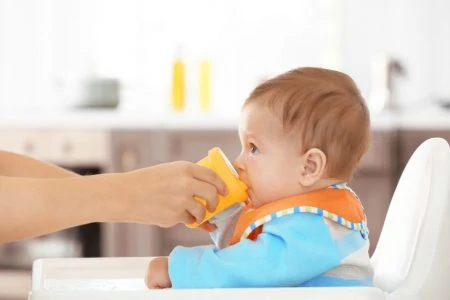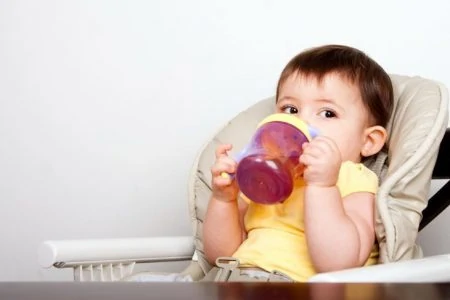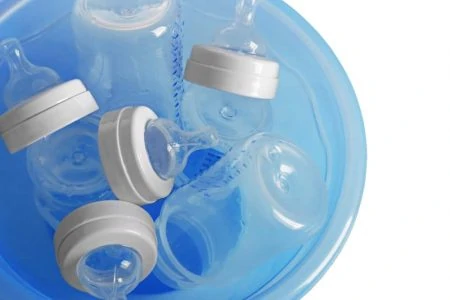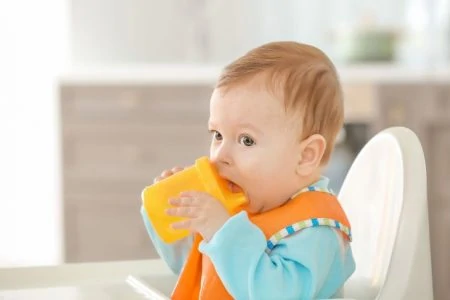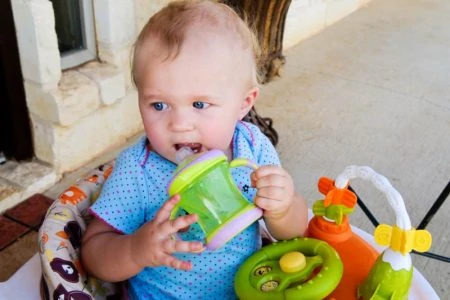However, relying on them for too long can create habits that are tough to break later. They can even impact your child’s dental and speech development.
If you are dreading the spills, don’t worry. We have a plan. Here is why you should make the switch sooner rather than later and how to transition to a regular cup without losing your mind.
Key Takeaways
- The American Academy of Pediatrics recommends weaning children from sippy cups by age 2.
- Prolonged use is linked to tooth decay, speech delays, and airway issues.
- Great alternatives include open cups, 360 cups, and straw cups.
- You can transition slowly by offering water only or limiting cups to mealtime.
When Should I Start Sippy Cup Weaning?
Sippy cups are great transitional tools. However, many of us buy into the idea that they are necessary throughout childhood to prevent messes. Think about it; nearly every restaurant automatically brings a lid and straw as soon as a child sits down.
The American Academy of Pediatrics advises parents to wean children from sippy cups by age 2 (1). Realistically, we know that deadline can be tricky.
A 2-year-old can drink from a regular cup, but they lack the coordination to prevent spills entirely.
We recommend you start weaning as much as possible by age 2. Use the sippy cup sparingly after that. Save it for the car or situations where a spill would be a disaster. Aim to be completely done by age 3.
Why Should I Wean My Child Off the Sippy Cup?
Sippy cups are convenient for parents. Unfortunately, overuse is associated with illness, injury, and developmental delays.
Here are the risks of using them too long:
- Illness caused by mold or mildew inside complex valves.
- Mouth injuries from falling while walking and drinking (2).
- Tooth decay and cavities from constant sipping.
- Damage to developing permanent teeth.
- Speech impediments like lisps.
- Improper airway development.
- Changes in facial structure/appearance.
- Weight gain due to “comfort feeding” on sugary drinks.
Sippy Cup Alternatives
Toddlers are not exactly graceful. Accidents happen. If you are not ready to go completely cup-free, there are better tools to bridge the gap.
Try these alternatives to the traditional hard-spout sippy cup:
- Open Cups: This is the gold standard. Small, cup-sized glasses (like a shot glass size or specific toddler cup) help teach proper lip closure and swallowing mechanics.
- 360 Cups (Rimless): These are fantastic transitional tools. They mimic drinking from a real cup but seal automatically when the child stops drinking. They are generally better for oral development than spouts.
- Straw Cups: Drinking from a straw strengthens lip muscles and promotes a more mature swallowing pattern. A simple cup with a lid and straw is a great compromise. It prevents major spills but still requires the child to keep the cup upright.
- Water Bottles: If you worry about hydration, a water bottle is fine for outings. Just ensure it is not attached to your child’s hand 24/7.
How Can I Limit Messes?
You should expect some spills as your child learns the ropes. However, you do not have to ruin your carpet in the process.
Here is how to minimize the damage:
- Kitchen only rule: Keep the open cups in the kitchen or dining room. It is much easier to wipe tile or laminate than to scrub grape juice out of the beige sofa.
- Water training: Only put water in open cups during the learning phase. Wiping up a water puddle is annoying, but it is not sticky or staining.
- Use a splash mat: Place a mat under your child’s high chair. A large, waterproof splash mat protects your floors and makes cleanup a breeze.
How To Transition Your Child to a Regular Cup
Ready to make the switch? Follow these steps to move from sippy cups to regular cups successfully.
1. Use a 360 Cup
If the thought of an open cup terrifies you, start with a 360 (rimless) cup. It requires the same mouth position and tipping motion as a regular glass. It helps children learn the mechanics without the flood.
2. Start With Small Amounts
The less liquid in the cup, the less you have to mop up. When introducing an open cup, pour only one or two inches of water into the bottom. Refill it as they finish.
As their motor skills improve, you can slowly increase the amount of liquid.
3. Assist Them Physically
Drinking from a cup is complex. It requires several skills working in unison:
- Lip closure and mouth placement.
- Swallowing without leaking.
- Depth perception (seeing the liquid level).
- Motor control to tip the cup gently.
Help your child by holding the cup with them. Guide it to their mouth and help them tip it slowly. Once they understand the concept, let them try it solo.
4. Swap to a Water Bottle
If your child carries a sippy cup for comfort, swap it for a water bottle. It serves the purpose of hydration without the “baby” association of a sippy cup.
Remember
5. Reserve Milk for Meals
Sippy cups are often prized because they contain tasty drinks like milk or juice. Break the association by serving milk or juice only at the table in a regular cup. Keep water in the portable bottles.
6. Set a Date and Prep Your Child
If you have a stubborn toddler, involve them in the plan. Pick a date to “retire” the sippy cups. Talk about it often so they know what to expect.
You can say, “You are getting so big! When you turn three, we are going to pack up the baby cups and use big kid cups only.”
7. Go Cold Turkey
Sometimes gradual transitions just drag out the pain. If you keep sippy cups in the cupboard, you will be tempted to use them.
If your child has the skills to drink from a regular cup, pack up the old ones and donate or toss them. If they aren’t an option, your child will adapt quickly.
FAQs
In Conclusion
Transitioning away from the convenience of sippy cups feels daunting. We get it. Nobody wants more puddles on the floor.However, moving to open cups or straws is one of the best things you can do for your child’s teeth and speech. Start small, be consistent, and embrace the occasional splash. Before you know it, your little one will be drinking like a pro.
